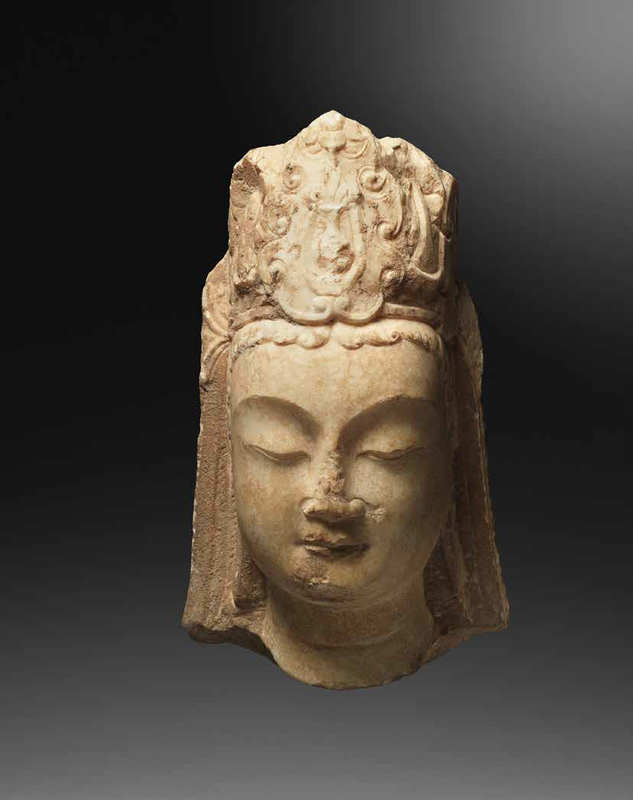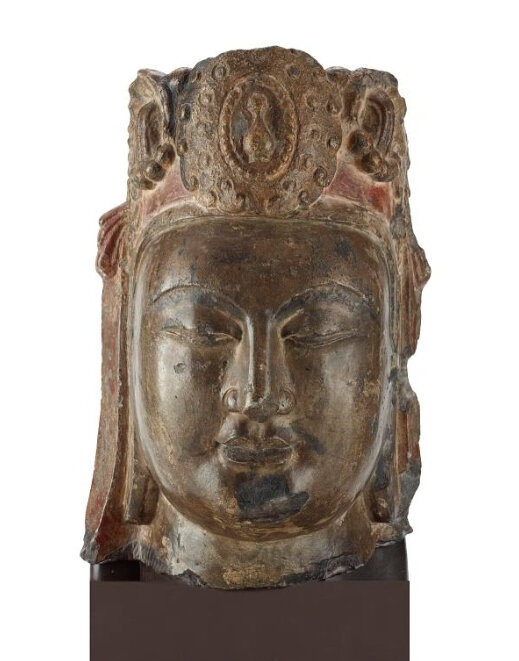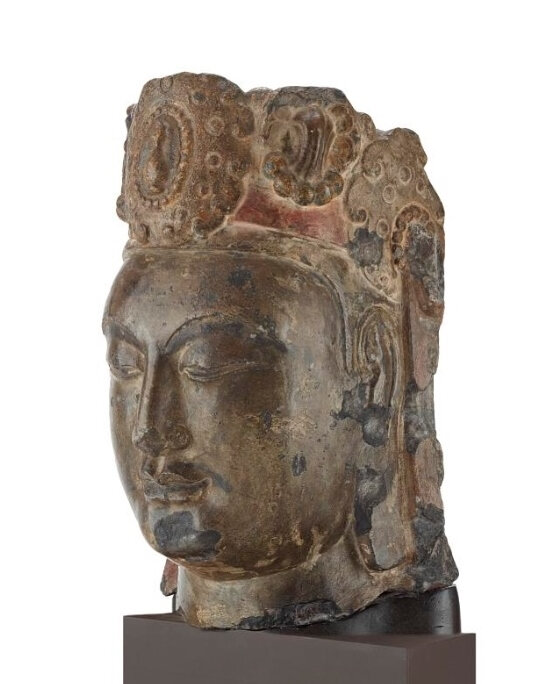A white marble head of Mahasthamaprapta, Northern Qi Dynasty (550-577)
Lot 31. A white marble head of Mahasthamaprapta, Northern Qi Dynasty (550-577); 34cm (13 3/8in) high. Estimate: £250,000.00 - £300,000.00 (€ 280,000 - 340,000). Sold for £ 308,750 (€ 354,221). © Bonhams.
The face gracefully carved with ample rounded brows tapering above slender undulating eyes barely open in meditation, the nose flaring above a sensuous bud mouth, with pendulous ears and hair arranged into a tall chignon secured by a delicate, foliate headdress tied with ribbons at the sides.
Provenance: Gisèle Croës Arts D'Extreme Orient, Brussels, 2006
Jean-Yves Ollivier Collection.
Note: Delicately carved from a highly translucent marble which further emphasises its elegant proportions and ethereal grace, the present head is a remarkable example of the high standards achieved in Buddhist portraiture during the Northern Qi period.
At this time, Buddhism flourished in China, with several shrines being constructed under the Emperor's personal auspices and eminent monks being appointed as state preceptors. Conspicuous financial resources were devoted to the construction of Buddhist caves whose marvellous sculptures combined sensuous modelling and subtlety of expression. These features were likely to have derived from the contemporary Indian style of the Gupta period, which was highly regarded by the Qi aristocracy for its exotic traits. In Buddhist faith, images of deities served as important foci of worship and also promoted significant devotional acts which contributed to the devotee's personal growth towards spiritual liberation.
According to Osvald Siren, marble figures modelled in gently rounded forms, such as the present example, were typically produced during the second half of the 6th century. See O.Siren, 'Chinese Marble Sculptures of the Transition Period', Bulletin of the Museum of Far Eastern Antiquities, no.12, Stockholm, 1940, pp.473-496.
The vase featured at the centre of the crown identifies the figure as Mahasthamaprapta, the Bodhisattva of Wisdom and one of the Eight Great Bodhisattvas of the Mahayana tradition of Buddhism. Images of Mahasthamaprapta were typically paired with those of Avalokiteshvara, the Bodhisattva of Compassion, in relation to the cult of Buddha Amitabha and the Pure Land which offered the ideal conditions for attaining awakening in a single lifetime.
Compare with a limestone head of a bodhisattva, Northern Qi dynasty, similarly modelled with arched brows and hair arranged in regular curls, coiling to each side from the centre, from the Nelson Atkins Museum, Kansas City (acc.no.F99-1). Another stone example bearing similar features to the present example is illustrated in Shandong Boxing Longhua si yizhi diaocha jianbao (Reconnaissance of the Site of the Longhua Temple at Boxing, Shandong), Kaogu, Beijing, 1986, vol.9, pl.6, fig.2. Also compare with two related limestone heads of Mahasthamaprapta, Northern Qi, respectively from the Freer Gallery of Art, Washington D.C. (acc.no.F1916.346), and the San Diego Museum of Art, (acc.no.DSC06522), the latter illustrated in K.Tsiang, Echoes of the Past: The Buddhist Cave Temples of Xiangtangshan, Chicago, 2010, p.230, fig.32.
Head of a Bodhisattva, Chinese, Northern Qi Dynasty (550-577 C.E.). Fine hard limestone, 8 1/2 x 4 x 5 inches (21.59 x 10.16 x 12.7 cm). Purchase: the Asian Art Aquisition Fund in memory of Laurence Sickman, F99-1. Nelson Atkins Museum, Kansas City.
Head of the Bodhisattva Mahasthamaprapta (Dashizhi), Northern Qi dynasty, 550-577. Limestone with traces of pigment. H x W x D: 36 x 24.5 x 24 cm. China, Hebei province, Fengfeng, southern Xiangtangshan, Caves 4-6. Gift of Charles Lang Freer, F1916.346, Freer Gallery of Art, Washington D.C.. © 2018 Smithsonian Institution.
Bonhams. The Ollivier Collection of Early Chinese Art, London, 8 Nov 2018

/https%3A%2F%2Fprofilepics.canalblog.com%2Fprofilepics%2F1%2F0%2F100183.jpg)
/https%3A%2F%2Fstorage.canalblog.com%2F03%2F02%2F119589%2F96711876_o.jpg)
/https%3A%2F%2Fstorage.canalblog.com%2F11%2F31%2F119589%2F94773502_o.jpg)
/https%3A%2F%2Fstorage.canalblog.com%2F20%2F83%2F119589%2F94772815_o.jpg)
/https%3A%2F%2Fstorage.canalblog.com%2F26%2F72%2F119589%2F75604929_o.jpg)
/https%3A%2F%2Fstorage.canalblog.com%2F59%2F60%2F119589%2F26458628_o.jpg)








/image%2F1371349%2F20240423%2Fob_b2fe42_telechargement-9.jpg)
/image%2F1371349%2F20240423%2Fob_af8bb4_telechargement-6.jpg)
/image%2F1371349%2F20240423%2Fob_b6c4a6_telechargement.jpg)
/image%2F1371349%2F20240423%2Fob_981d5f_h22891-l367411650-original.jpg)